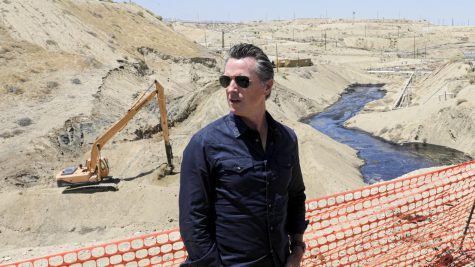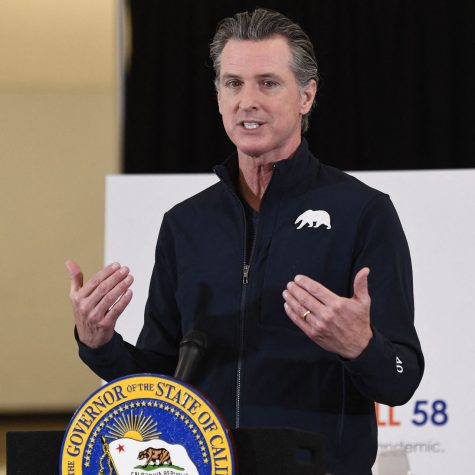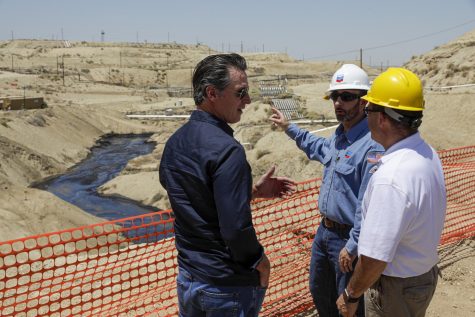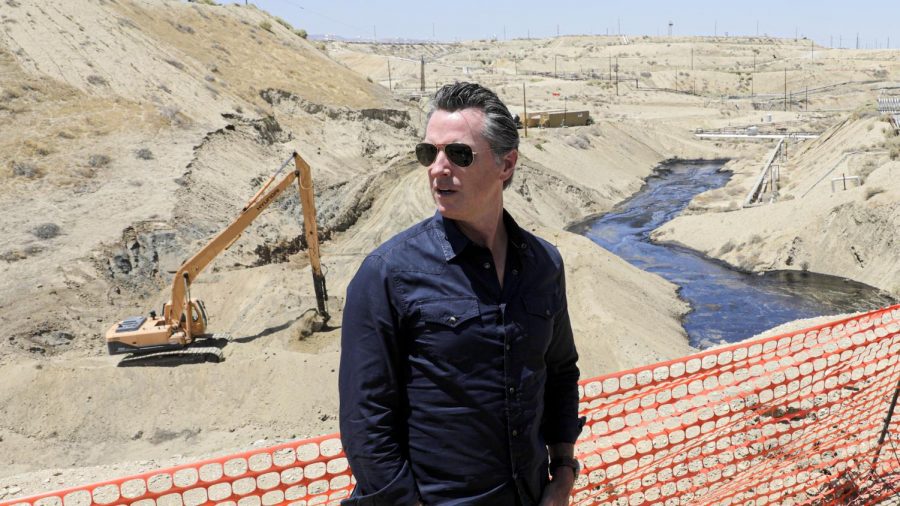Out with the oil; in with the New(som) regulations
Gov. Gavin Newsom visits a creek in McKittrick, California, where more than 800,000 gallons of oil has been spilled.
June 9, 2021
On April 23 in a press release, California Governor Gavin Newsom announced his plans to phase out all fracking, also known as hydraulic fracturing, by January 2024. This ban will make California the eighth state to ban fracking. The fracking process includes injecting water, chemicals and sand at high pressure to create small fractures in order to extract energy from an underground natural gas or oil deposit. California is now also the first state in the country to declare an end to oil extraction, which Newsom intends to ban by 2045. In the same mid-April press release, Newsom said he intends to achieve net-zero carbon dioxide emissions in an effort to combat climate change also by 2045.
“The climate crisis is real, and we continue to see the signs every day. As we move to swiftly decarbonize our transportation sector and create a healthier future for our children, I’ve made it clear I don’t see a role for fracking in that future and, similarly, believe that California needs to move beyond oil,” Newsom said in his press release.

According to a statement from Newsom’s office, the California Air Resources Board (CARB) will evaluate how to phase out oil extraction through the Climate Change Scoping Plan, which will achieve reductions in greenhouse gas emissions.
During fracking, methane is released into the atmosphere, as well as carbon dioxide equivalents, which both have similar global impacts. California is banning this process because of its negative impact and effects on the environment, which are largely the greenhouse gas emissions.
The California Department of Conservation’s Geologic Energy Management (CalGEM), which protects public health and the environment, will start its own process immediately. Although CalGEM’s plan is not the same as CARB’s, they are both working to improve California’s community. According to CalGEM, their method includes developing new regulations to protect workers and groups, implementing new laws that prohibit surface expressions and increasing financial bonding requirements on oil companies to ensure adequate closure of defunct wells and clean-up of inactive oil fields.
In the U.S., California is ranked seventh in producing the most oil and will be the largest state (in terms of oil-production) to ban fracking. Additionally, 50 percent of California’s greenhouse gas emissions come from the transportation sector, a much greater number than most other states. Finally, Newsom’s plan to ban fracking is expected to lower California’s greenhouse gas emissions numbers significantly.

On the other hand, lawmakers across the United States have been skeptical about the ban, due to Newsom’s misleading statement that the role of fracking only makes up about 2 percent of production in California, while it actually makes up 17 percent, according to industry groups. This has resulted in controversy over the significance of the fracking ban. According to Associated Press News, banning fracking will not actually reduce the state’s dependency on oil, but California will actually just require it to be imported from other places.
“We’re still going to use it, but we’re going to use it from places that produce it less safely… I don’t think we’re quite there yet, and this bill assumes that we are,” California State Democratic Senator Susan Eggman said in a committee hearing in early April.
However, Jared Blumenfeld, the California secretary of environmental protection, spoke in a New York Times article regarding California’s plan for fracking and carbon emissions and why it is necessary.
“We really wanted a bold goal to end oil extraction in the state. Fracking is part of the bigger picture about where we want to go toward our carbon neutrality goal,” Blumenfeld said.
A carbon neutrality goal will also affect the economy, and Wade Crowfoot, California’s natural resources secretary, explained the future of California to the New York Times with fiscal concerns in mind. By implementing this proposal, government officials worry it will eliminate well-paying jobs that many communities rely on.
“What we need to do is be able to identify and grow good-paying jobs in these technologies that will power California’s future economy. That includes renewable fuels, renewable energy – including offshore wind – and the remediation of oil fields. We’re working in partnership with impacted places to develop those opportunities,” Crowfoot said. “And even though there are benefits of banning fracking, people believe that it isn’t super crucial right now.”
Contrastingly, Gustavo Aguirre Jr., the Kern County director for the Central Coast Environmental Justice Network, says that ending fracking is necessary because it can cause problems in communities, as well as in the atmosphere.
“Climate change is manifesting and we know what the problem is so I think in order to protect Californians and really the Western hemisphere, we definitely need to ban practices like [fracking] that are extreme not only [to] the local groundwater and air quality, but [to] the longevity and the sustainability of the next generation,” Aguirre Jr. said in an interview with the Californian.

As the year continues, California becomes closer to a net-zero carbon emissions footprint. California’s fracking ban is a huge step for lowering greenhouse gas emissions and ultimately fighting against climate change. Newsom’s plan is one that should pave the way for the rest of the United States.








